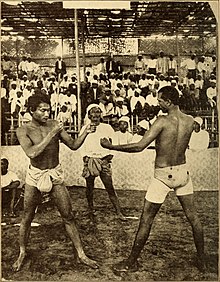Longyi
A longyi (Burmese: လုံချည်; MLCTS: lum hkyany; pronounced [lòʊɰ̃dʑì]) is a sheet of cloth widely worn in Myanmar (Burma).
It gained popularity during British colonial rule, effectively replacing the paso and htamein of precolonial times.
[7] A western visitor to Rangoon in the 19th century wrote: Nearly all the men are naked to the waist, or wear a small white open linen jacket, with a voluminous putso [paso] wound tightly round their loins and gathered into a great bundle or knot in front.
[6]However, with the onset of colonial rule, Lower Burma and urban areas more readily adopted the longyi worn in the Malay and Indian style, which was considered more convenient to wear.
Men wear the modern paso by making a fold on either side in front and tied by tucking them together at the waist just below the navel.
Longyis are generally sold unsewn but nowadays they are available ready to wear; htameins may even be sewn like Western skirts.
Men's pasos are generally stripes or checks apart from plain colours and may be worn upside down or inside out with no difference.
In ancient times silks generally were worn by royalty and courtiers, the royal pasos and htameins richly embroidered with gold, silver, pearls and precious stones.
Men often tuck the lower portions of their pasos at the top by bunching it in the front then passing it up between the legs round the back to the waist, known as paso hkadaung kyaik and, rather like the dhoti, usually for climbing and sporting activities instead of changing into shorts or trousers.
In rural areas men are often seen with a folded paso on one shoulder either for use when bathing (yei lè — lit.
Washing and ironing cannot be simpler as they are cylindrical pieces of cloth, easily hung, pressed, folded and stacked with a bare minimum use of wardrobe space.
Nowadays, in Lethwei matches fighters wear shorts which arbor a flag reminiscing of the longyi ancient days.







